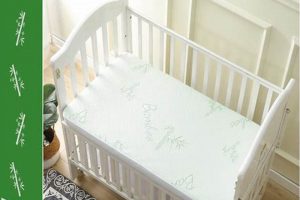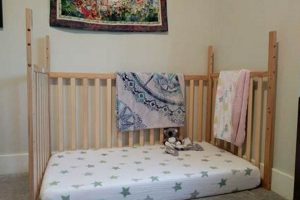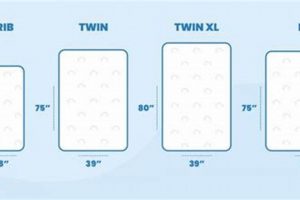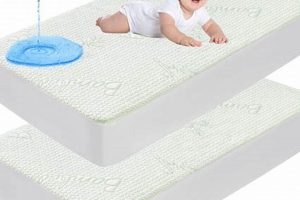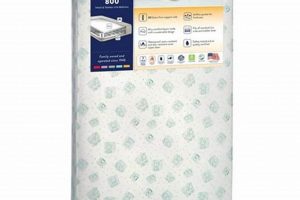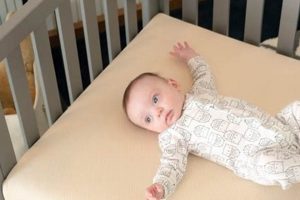An extra-firm, waterproof sleep surface designed for infants, specifically tailored to fit standard-sized baby cribs, serves as a foundational element in a safe and supportive nursery environment. This type of product aims to provide a stable and hygienic platform for a baby’s sleep, influencing their comfort and potentially their physical development during crucial early stages.
The attributes of firmness and waterproofing are central to its significance. Extra firmness is often recommended by pediatricians to reduce the risk of Sudden Infant Death Syndrome (SIDS) by preventing the infant from sinking into the mattress. Waterproofing ensures ease of cleaning and prevents the absorption of fluids, mitigating the growth of bacteria and mold, thereby contributing to a healthier sleep environment. Historically, simpler designs have evolved to incorporate these safety and hygiene features, reflecting increased awareness of infant health considerations.
Understanding the materials used in its construction, the certifications it holds, and the proper care instructions will provide a comprehensive overview of its value and longevity as a nursery essential. Further exploration will cover aspects such as safety standards, cleaning protocols, and comparative analyses with similar products on the market.
Guidance on Selection and Maintenance
The following recommendations are intended to provide clarity on the appropriate use and upkeep of an extra-firm, waterproof infant sleep surface, contributing to the creation of a safe and hygienic sleep environment for the child.
Tip 1: Verify Crib Compatibility: Ensure the dimensions of the mattress precisely match the interior dimensions of the crib. Gaps between the mattress and crib frame pose a safety hazard.
Tip 2: Assess Firmness: Confirm the surface is indeed extra-firm. It should not easily compress under slight pressure. A soft surface can increase the risk of suffocation.
Tip 3: Review Waterproofing Integrity: Periodically inspect the waterproof layer for any signs of tears or damage. Compromised waterproofing can lead to bacterial growth and compromise the mattress’s hygienic properties.
Tip 4: Establish a Cleaning Protocol: Regularly wipe down the sleep surface with a mild, non-toxic cleaner. Avoid harsh chemicals that could degrade the waterproof layer or pose a risk to the infant.
Tip 5: Utilize Fitted Sheets: Always use a fitted sheet specifically designed for crib mattresses. Ensure the sheet fits snugly and does not bunch up, which could create a suffocation hazard.
Tip 6: Monitor for Wear and Tear: Regularly check for any signs of sagging, indentations, or other forms of wear. Replace the sleep surface if significant deterioration is observed.
Tip 7: Adhere to Safety Standards: Verify that the sleep surface meets current safety regulations and is certified by relevant organizations. These certifications indicate adherence to specific safety and performance criteria.
The selection and consistent upkeep of the sleep surface are crucial components of establishing a safe and healthy sleep environment for the infant. Diligent attention to these factors can mitigate potential risks and contribute to the child’s well-being.
Considerations regarding further exploration of related topics, such as proper bedding choices and safe sleep practices, are warranted for a comprehensive understanding of infant sleep safety.
1. Firmness Support
The term “firmness support,” when associated with a “sealy ortho rest extra firm waterproof baby crib mattress,” refers to a critical design characteristic intended to promote infant safety and proper skeletal development. The correlation between mattress firmness and reduced risk of Sudden Infant Death Syndrome (SIDS) is a primary driver behind this design specification. An extra-firm surface minimizes the likelihood of an infant sinking into the mattress, thereby reducing the risk of airway obstruction. This constitutes a direct cause-and-effect relationship where increased firmness directly contributes to improved respiratory safety.
The “Ortho Rest” component of the product name implies an additional focus on orthopedic support. This suggests the mattress construction is engineered to maintain proper spinal alignment during sleep. For example, a mattress that lacks adequate firmness can lead to spinal misalignment, potentially affecting long-term musculoskeletal health. The extra-firm characteristic, therefore, serves as a preventive measure against such developmental issues. In practical application, this enhanced support can contribute to improved comfort and reduced pressure points during sleep, potentially leading to longer and more restful sleep periods for the infant.
In summary, the firmness support attribute is not merely a comfort feature but a fundamental safety and developmental consideration inherent in the design of an extra-firm baby crib mattress. Ensuring adequate firmness, as certified by relevant safety standards, directly contributes to a safer sleep environment and supports healthy skeletal development. The challenge lies in maintaining this firmness over the mattress’s lifespan and verifying its continued efficacy through regular inspection and adherence to manufacturer guidelines. This attribute serves as a crucial link to the broader objective of creating a secure and developmentally sound nursery environment.
2. Waterproof Barrier
The incorporation of a waterproof barrier in a “sealy ortho rest extra firm waterproof baby crib mattress” is not merely a convenience feature; it is a fundamental element directly influencing hygiene, safety, and longevity. It protects the mattress core from fluids, thereby mitigating the growth of bacteria and mold, and preserving the integrity of the mattress over time.
- Hygiene and Health
The waterproof barrier prevents the absorption of bodily fluids, such as urine, saliva, and spit-up, which are commonplace in an infant’s environment. Absorption of these fluids would create a breeding ground for bacteria and mold, posing a significant health risk to the infant. The barrier allows for easy cleaning and disinfection, maintaining a sanitary sleep surface.
- Mattress Longevity
Without a waterproof barrier, liquids would permeate the mattress core, leading to degradation of internal materials. This degradation can compromise the structural integrity of the mattress, reducing its lifespan and potentially affecting its firmness support. The barrier effectively extends the useful life of the product.
- Allergen Control
The barrier not only prevents the growth of mold and bacteria but also hinders the accumulation of allergens such as dust mites. A waterproof and easily cleanable surface minimizes allergen exposure, contributing to a healthier sleep environment for infants susceptible to allergies.
- Ease of Maintenance
The presence of a waterproof layer simplifies cleaning procedures. Spills and accidents can be quickly wiped away with a damp cloth and mild detergent, preventing stains and odors. This ease of maintenance is a practical benefit for caregivers, promoting consistent hygiene.
These interconnected facets demonstrate that the waterproof barrier is an indispensable component of the product. It ensures hygiene, prolongs the mattress lifespan, controls allergens, and simplifies maintenance, solidifying its role as a critical feature in safeguarding infant health and well-being within the nursery environment. The effectiveness of this barrier, however, hinges on its material composition and structural integrity, warranting careful consideration during product selection.
3. Ortho Rest Design
The term “Ortho Rest Design,” when used in conjunction with a “sealy ortho rest extra firm waterproof baby crib mattress,” implies a specific engineering focus on orthopedic support and proper spinal alignment for infants. This design element aims to address the unique needs of a developing musculoskeletal system during sleep. Further examination of its core components reveals its intended function and significance.
- Spinal Alignment Support
The primary objective of an “Ortho Rest Design” is to maintain proper spinal alignment. Infants spend a significant portion of their early months sleeping, making this support crucial for healthy development. Inadequate support can lead to spinal stress or misalignment, potentially affecting posture and musculoskeletal function later in life. This design seeks to minimize these risks through optimized mattress construction.
- Pressure Point Reduction
An effective “Ortho Rest Design” also aims to distribute weight evenly across the sleep surface, reducing pressure points. Infants are particularly susceptible to pressure-related discomfort, which can disrupt sleep patterns. By minimizing concentrated pressure, this design enhances comfort and promotes more restful sleep.
- Material Composition and Density
The materials used in an “Ortho Rest Design” are selected for their specific properties, including density, resilience, and support. Higher density materials provide greater support and resistance to compression, ensuring consistent spinal alignment. The arrangement and layering of these materials are critical for achieving the desired orthopedic benefits. Material should be tested and certified for safety.
- Ventilation and Temperature Regulation
While primarily focused on orthopedic support, an “Ortho Rest Design” may also incorporate features to enhance ventilation and temperature regulation. Overheating can disrupt sleep and increase the risk of SIDS. Breathable materials and ventilation channels can help maintain a comfortable and safe sleep temperature.
These facets collectively highlight the intention of the “Ortho Rest Design” to provide a supportive and comfortable sleep environment conducive to healthy musculoskeletal development. Its effectiveness hinges on the specific materials, construction techniques, and manufacturing standards employed. Assessing these factors is essential for determining the true orthopedic value of the mattress. While the “Ortho Rest Design” aims to provide optimal support, it should be considered within the broader context of safe sleep practices, including appropriate bedding and positioning.
4. Crib Compatibility
Crib compatibility represents a non-negotiable safety prerequisite when considering a “sealy ortho rest extra firm waterproof baby crib mattress.” The dimensions of the mattress must precisely align with the interior dimensions of the crib frame to prevent gaps. These gaps pose a significant entrapment risk, potentially leading to suffocation. For instance, if a mattress is too small, an infant could become wedged between the mattress edge and the crib side. Conversely, a mattress that is too large might compress against the crib frame, creating an uneven sleeping surface that could also compromise infant safety.
Federal regulations and industry standards mandate specific crib dimensions to promote compatibility with standard-sized mattresses. A standard crib mattress typically measures approximately 27 1/4 inches wide by 51 5/8 inches long. Deviations from these dimensions, even slight ones, can undermine the safety of the sleep environment. For example, using an older crib designed to accommodate a non-standard mattress size with a modern, standard-sized mattress is a hazardous practice. Prior to purchasing a mattress, caregivers must accurately measure the interior of the crib and verify that the mattress dimensions comply with established safety guidelines. A tight, secure fit eliminates potential entrapment hazards, ensuring a safe sleep space.
In summation, the connection between crib compatibility and the selection of a “sealy ortho rest extra firm waterproof baby crib mattress” is one of direct causality: incompatibility creates demonstrable safety risks. Accurate measurements, adherence to established standards, and a commitment to eliminating gaps are essential to mitigating these risks. Crib compatibility is not merely a matter of convenience but a critical determinant of infant safety within the nursery environment. Ensuring a proper fit is paramount to minimizing potential hazards and promoting a secure sleep space.
5. Material Safety
Material safety is paramount in the design and construction of a “sealy ortho rest extra firm waterproof baby crib mattress” due to the infant’s vulnerability and prolonged exposure to the product. The selection of materials has a direct cause-and-effect relationship with the infant’s health, where non-toxic and hypoallergenic materials minimize the risk of allergic reactions, respiratory issues, and skin irritation. For instance, the use of polyurethane foam containing volatile organic compounds (VOCs) can lead to off-gassing, which may cause respiratory distress in sensitive infants. Conversely, utilizing certified organic cotton and plant-based foams reduces the likelihood of such adverse effects, promoting a healthier sleep environment. The importance of material safety is underscored by numerous instances where infants have suffered adverse reactions due to exposure to harmful chemicals present in crib mattresses. The practical significance of this understanding lies in empowering caregivers to make informed purchasing decisions based on material composition and certifications, prioritizing the infant’s well-being.
Further analysis reveals that material safety extends beyond the primary components, encompassing adhesives, flame retardants, and waterproofing agents. Traditional flame retardants, such as polybrominated diphenyl ethers (PBDEs), have been linked to developmental issues and endocrine disruption. Safer alternatives, such as inherently flame-resistant materials or chemical-free barriers, are crucial for minimizing toxic exposure. The waterproof layer, often made of vinyl or PVC, can also contain phthalates, which are known endocrine disruptors. Alternatives like polyethylene or TPU (thermoplastic polyurethane) offer comparable waterproofing without the associated health risks. Practical application of this knowledge involves scrutinizing product labels, seeking certifications from independent organizations like GREENGUARD Gold or CertiPUR-US, and contacting manufacturers to obtain detailed information about material sourcing and testing procedures. Selecting a “sealy ortho rest extra firm waterproof baby crib mattress” with transparently sourced, certified safe materials represents a proactive approach to protecting infant health.
In conclusion, material safety is an indispensable component of a “sealy ortho rest extra firm waterproof baby crib mattress.” Its proper implementation directly impacts infant health and development, mitigating the risks associated with toxic chemical exposure. The challenge lies in navigating the complexities of material composition and certifications, requiring caregivers to be diligent and informed consumers. By prioritizing material safety, caregivers contribute to a safer and healthier nursery environment, fostering optimal conditions for infant growth and well-being. This focus is not merely a trend but a fundamental responsibility, ensuring that the crib mattress supports, rather than compromises, the infant’s health and development.
6. Cleanability
Cleanability, in the context of a “sealy ortho rest extra firm waterproof baby crib mattress,” is not merely a desirable attribute; it is an essential characteristic directly affecting hygiene, infant health, and the long-term usability of the product. The capacity to readily remove contaminants from the sleep surface mitigates the proliferation of harmful microorganisms and allergens, thereby fostering a healthier environment for the infant.
- Waterproof Surface Integrity
The primary component facilitating cleanability is the waterproof surface. This barrier prevents the penetration of fluids, such as bodily excretions, spills, and cleaning solutions, into the mattress core. A compromised waterproof layer undermines cleanability, allowing for the accumulation of contaminants that cannot be readily removed. The material used must withstand repeated cleaning without degradation.
- Material Resistance to Staining
The surface material’s resistance to staining significantly impacts cleanability. A material that readily absorbs stains necessitates more rigorous cleaning efforts and may retain residual discoloration, even after cleaning. This can compromise hygiene and affect the perceived cleanliness of the sleep surface. Materials with inherent stain-resistant properties enhance cleanability and contribute to a more sanitary environment.
- Ease of Disinfection
Beyond simple cleaning, the ability to effectively disinfect the sleep surface is crucial. The material must be compatible with commonly used disinfectants that eliminate bacteria, viruses, and fungi without causing damage or releasing harmful chemicals. A surface that cannot be adequately disinfected poses an ongoing risk of microbial contamination, undermining infant health.
- Accessibility for Cleaning
The design of the mattress should facilitate easy access for cleaning. Features such as smooth surfaces, minimal seams, and rounded corners minimize the accumulation of dirt and debris and allow for effortless wiping. Intricate designs or textured surfaces can impede cleaning efforts, increasing the likelihood of contaminant retention.
In summary, the cleanability of a “sealy ortho rest extra firm waterproof baby crib mattress” is a multifaceted attribute dependent upon the integrity of the waterproof layer, the stain resistance of the surface material, the ease of disinfection, and the accessibility for cleaning. These factors collectively determine the effectiveness of cleaning protocols and the maintenance of a hygienic sleep environment, highlighting the importance of selecting a product designed for optimal cleanability to safeguard infant health and extend the product’s useful lifespan. A failure to address cleanability adequately can negate the benefits of other safety features, rendering the mattress a potential source of contamination.
7. Durability
Durability, with respect to a “sealy ortho rest extra firm waterproof baby crib mattress,” signifies the product’s capacity to withstand prolonged use and maintain its structural integrity, safety features, and hygiene standards over an extended period. The lifespan of a crib mattress directly impacts its cost-effectiveness and the long-term safety of the infant. Reduced durability can lead to compromised firmness, diminished waterproof protection, and the degradation of materials, all of which negatively affect the mattress’s intended purpose.
- Material Endurance
The inherent durability of the materials used in the mattress construction is a primary determinant of its overall lifespan. Higher quality materials, such as high-density foam, reinforced seams, and durable waterproof coverings, exhibit greater resistance to wear and tear. Examples of material failure include foam compression, seam splitting, and delamination of the waterproof layer, all of which compromise the mattress’s structural integrity. The choice of materials directly influences the long-term performance and safety of the product.
- Construction Integrity
The manner in which the mattress components are assembled significantly affects its durability. Robust construction techniques, such as reinforced stitching, secure bonding of layers, and proper edge support, enhance the mattress’s resistance to deformation and breakdown. Conversely, substandard construction can lead to premature failure, resulting in sagging, uneven surfaces, and potential safety hazards. The quality of construction is a critical factor in determining the mattress’s ability to withstand the rigors of daily use.
- Resistance to Degradation
The mattress’s ability to resist environmental factors, such as moisture, temperature fluctuations, and ultraviolet (UV) exposure, contributes to its overall durability. Prolonged exposure to these elements can accelerate material degradation, leading to reduced firmness, compromised waterproof protection, and the growth of mold and bacteria. Materials with inherent resistance to these environmental stressors exhibit greater longevity and maintain their functionality over an extended period.
- Maintenance Impact
Proper maintenance practices, such as regular cleaning, the use of appropriate bedding, and adherence to manufacturer guidelines, directly impact the mattress’s durability. Neglecting these practices can accelerate wear and tear, leading to premature failure. Conversely, diligent maintenance can prolong the mattress’s lifespan and preserve its safety and hygiene standards. Caregiver adherence to recommended maintenance protocols is essential for maximizing the product’s durability.
These interconnected facets underscore that the durability of a “sealy ortho rest extra firm waterproof baby crib mattress” is a complex function of material selection, construction techniques, environmental resistance, and maintenance practices. Investing in a mattress with robust durability characteristics represents a cost-effective and safety-conscious decision, ensuring a stable and hygienic sleep environment for the infant throughout its intended lifespan. Lack of attention to these factors can compromise the safety and well-being of the infant.
Frequently Asked Questions
The following frequently asked questions aim to address common concerns and misconceptions regarding the “sealy ortho rest extra firm waterproof baby crib mattress.” The information provided is intended to offer clarity and promote informed decision-making.
Question 1: What is the recommended age range for use of this mattress?
The “sealy ortho rest extra firm waterproof baby crib mattress” is designed for infants from newborn to approximately 12-18 months, or until the child transitions to a toddler bed. Caregivers should consult pediatric guidance regarding individual developmental milestones.
Question 2: How should the mattress be cleaned and disinfected?
The mattress surface should be cleaned regularly using a damp cloth and mild, non-toxic soap. For disinfection, a diluted bleach solution (as per manufacturer instructions) or a commercially available disinfectant safe for infant use can be applied. Allow the surface to air dry completely before placing bedding.
Question 3: What safety certifications does this mattress possess?
Prospective purchasers should verify the presence of certifications from independent organizations such as GREENGUARD Gold, CertiPUR-US, or similar bodies. These certifications indicate adherence to stringent chemical emissions and safety standards.
Question 4: What is the expected lifespan of the mattress?
The lifespan of the “sealy ortho rest extra firm waterproof baby crib mattress” depends on usage and maintenance. However, it is generally expected to last for the duration of the infant’s crib usage period, provided proper care and cleaning protocols are followed. Regular inspection for signs of wear and tear is recommended.
Question 5: How firm is “extra firm,” and is it safe for newborns?
“Extra firm” refers to a high level of resistance to compression. This firmness level is generally recommended by pediatricians to reduce the risk of SIDS by preventing the infant from sinking into the mattress. Confirm firmness meets current safety standards and consult a pediatrician if concerns arise.
Question 6: What type of crib is compatible with this mattress?
The “sealy ortho rest extra firm waterproof baby crib mattress” is designed to fit standard-sized cribs. Accurate measurement of the crib’s interior dimensions is crucial to ensure a snug and secure fit, eliminating potential entrapment hazards.
Adherence to safety standards, regular cleaning, and careful monitoring are essential for maximizing the safety and longevity of this product.
The following section will address comparisons with alternative crib mattress options.
Conclusion
The preceding analysis has dissected the salient features of the “sealy ortho rest extra firm waterproof baby crib mattress,” emphasizing aspects such as firmness support, waterproof integrity, orthopedic design, crib compatibility, material safety, cleanability, and durability. Each attribute contributes critically to the creation of a safe, hygienic, and developmentally supportive sleep environment for infants. The interplay of these characteristics dictates the mattress’s efficacy in mitigating potential health risks and promoting optimal physical well-being during a crucial developmental stage.
Ultimately, the selection of a crib mattress transcends mere purchasing considerations; it represents a commitment to safeguarding infant health and fostering optimal development. Caregivers are encouraged to prioritize informed decision-making, scrutinizing product specifications, certifications, and maintenance protocols to ensure alignment with established safety guidelines and individual infant needs. A proactive approach to crib mattress selection contributes substantially to the creation of a secure and nurturing sleep environment, laying the foundation for healthy growth and development.


